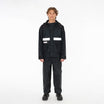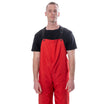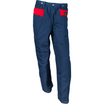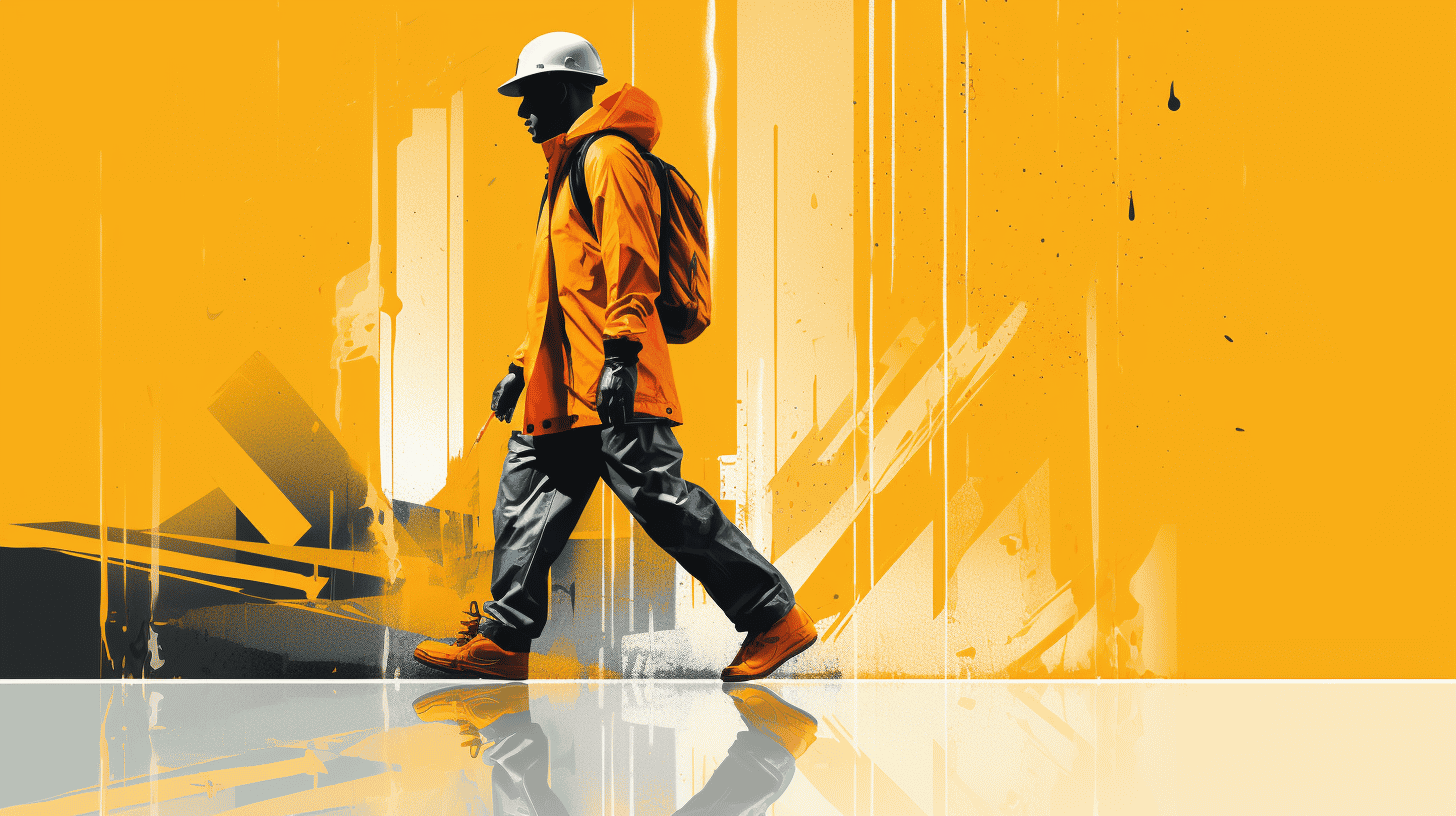As any construction professional knows, the weather doesn't always cooperate with project deadlines. Even when the sky unleashes torrential rains, work must continue. The only way to accommodate this unpredictable element is by being equipped with the right rain gear. Not only does it ensure productivity, but it also guarantees safety in challenging weather conditions. This guide will act as your comprehensive assistant to picking the right rain gear for construction jobs, explaining why it's crucial, aspects to consider while selecting, various types available, and caring and maintenance tips. So before you dismiss that drizzly forecast, stick around and give this a read. It might just make the difference between a miserable, chilly workday and a comfortable, productive one.
Understanding the Need for Rain Gear in Construction
The construction industry, with its open-air worksites and physically demanding tasks, relies heavily on fair weather conditions. However, works can't always come to a halt due to a downpour. Considering inclement weather is an inevitable part of the construction industry, preparing for it with the right gear is crucial. It's here that rain gear becomes an invaluable part of a worker's wardrobe, ensuring they can perform their duties without discomfort or risk. Rain gear for construction workers is not just about staying dry—it addresses issues associated with exposure to weather elements, maintaining construction workflow, and officers' safety aspects.
Exposure to Weather Elements
To say construction workers are exposed to the elements would be an understatement. Work often continues even in unfavorable conditions, primarily if the project is time-sensitive.
- In harsh conditions, without proper rain gear, workers are not only uncomfortable but also at risk of health complications such as hypothermia.
- Breathing in cold air or getting drenched may lead to respiratory issues.
- Excessive moisture can also lead to skin problems.
Investing in quality rain gear ensures workers can tackle their jobs no matter the weather, allowing them to remain comfortable and healthy.
Maintaining Construction Workflow
Beyond just the wellbeing of the workers, rain gear helps maintain the workflow of the construction site.
- When workers are adequately equipped for rain, they can continue their tasks without slowing down or stopping, ensuring the project stays on schedule.
- Having rain gear handy also means less time wasted on changing clothes or waiting for materials to dry.
- Additionally, gear like rainproof tool bags keeps vital tools dry and usable, so no equipment failure interrupts the workflow.
Safety Considerations
Perhaps the most crucial aspect of rain gear is safety. Construction sites can be dangerous – even more during a downpour.
- Rain can make surfaces slippery, increase the risk of electrical shocks, and decrease visibility.
- Quality rain gear is designed with these challenges in mind, often incorporating features like non-slip soles, reflective accents for visibility, and waterproofing.
Rain gear is not merely an optional extra for construction workers. It's a necessity. It protects them from health risks associated with persistent exposure to wet and cold conditions, ensures the smooth operation of the construction site, and significantly improves overall safety. Therefore, employers and workers alike should place high importance on sourcing quality rain gear as part of standard site equipment.
Key Factors in Selecting Rain Gear for Construction Work
When it comes to weather challenges in construction work, rain can make the job more difficult and potentially hazardous. Having the right gear not only ensures comfort but also increases productivity. Let's delve into the key factors you should consider when selecting your rain gear.
Material
Rain gear can be crafted from diverse materials, all offering different levels of durability, waterproofness, and price point. Some popular options include:
- PVC (Polyvinic chloride): This is a commonly used material and is effective in offering complete waterproof protection.
- Nylon with a waterproof coating: While not as rugged as PVC, this is a lightweight option and is also fairly durable.
- Gore-Tex or other breathable fabrics: These materials are typically a bit more expensive but offer exceptional breathability while still protecting against the rain.
Waterproof vs Water Resistant
Always remember, waterproof and water-resistant are not the same. A waterproof garment is designed to provide full protection against rain, even during a downpour. On the other hand, water-resistant gear will keep you dry in light to moderate rain but may not hold up during heavy, prolonged rain. Depending on your work environment and the local weather patterns, you may want to consider which attribute is more suited to your needs.
Size and Fit
Like any workwear, rain gear needs to fit correctly. Gear that's too large can restrict your movement and even create safety hazards, while gear that's too small may not provide full coverage against the rain. Take your measurements accurately, and don't forget to account for the clothing you'll be wearing underneath.
Breathability
Breathable gear is crucial for comfort, particularly if you're physically active during your work. Non-breathable materials can trap sweat, making your clothing damp, and reducing your body temperature - an aspect to seriously evaluate when working in colder climates.
Durability
Construction work can be demanding, and your rain gear needs to be able to withstand the elements and the rigours of the worksite. Pay extra attention to the durability of the material and the construction quality, including the reinforcement in high-wear areas and the quality of the seams.
Price
There's always a balance to be struck between cost and quality. While higher-priced gear often comes with added features like breathability and durability, lower-cost gear can still provide adequate protection against the rain.
Other Considerations: Zippers, Vents, and Pockets
Additional features may also sway your choice of rain gear. For instance, quality zippers can increase the lifespan of your gear. Vents can add to the breathability, and extra pockets always come in handy on a construction site.
In conclusion, your selection of rain gear should be influenced by your own needs and the specific demands of your worksite. Considering these key factors will ensure that your chosen gear not only keeps you dry but also enhances your productivity and safety.
Types of Rain Gear Suited for Construction Jobs
When working in the construction industry, you're not just building structures; you're battling the elements. One of the most common challenges faced is rain, often disrupting the workflow and making conditions difficult and dangerous. Fortunately, the right rain gear can make all the difference, allowing tasks to be carried out smoothly, despite the downpour. These are essential pieces for any construction worker to include in their workwear arsenal as they drastically increase safety while also strengthening productivity.
Rain Jackets
An excellent rain jacket is the cornerstone of any rain gear as it provides the first line of defense against pesky precipitation. Look for a design that is both waterproof and breathable to prevent ingression of water while also allowing sweat to escape. When selecting a rain jacket, remember to consider the visibility features as well. Stripes or patches of high-visibility colors and reflective materials can make a world of difference, particularly in poorly lit environments or during nasty weather conditions.
Rain Pants or Bibs
When the rain starts pouring, it's not just your upper body that is susceptible to soaking. Rain pants or bibs are a fundamental part of rain gear, providing a waterproof and durable outer shell for your lower half. Ideally, seek rain pants or bibs that are resistant to tears and cuts, especially if you'll be working around sharp materials and tools.
Rain Boots
Puddles and potential slippage are a constant threat on a construction site; hence a robust pair of rain boots is critical in managing these risks. The best rain boots for construction work are both waterproof and slip-resistant, offering sure footing even when surfaces are slick or muddy. Additionally, protective toe features could also be considered as they can prevent severe injuries from accidental impacts or drops.
Waterproof Gloves
Whether you're handling power tools or hauling materials, keeping a secure grip is crucial in construction work. A good pair of waterproof gloves can ensure your hands stay dry, warm, and maintain their dexterity. These gloves should be made from a strong material that can withstand constant use and still protect your hands from both moisture and cold.
Ponchos
While it might seem trivial, a poncho can be a construction worker's best friend in sudden showers or storms. Lightweight and easy to pack, a poncho can be quickly thrown on over your other rain gear for an extra layer of protection. Plus, if they're brightly colored or have high-visibility markings, they can also help enhance visibility on the site.
When building a career in construction, remember to build a solid collection of reliable rain gear too. It's an investment in your comfort, safety, and productivity. After all, when the weather refuses to cooperate, the right equipment can make sure your workflow doesn't skip a beat. Remember, each piece contributes to a secure and efficient workspace, shielding you from the elements while you focus on building the world around you.
Maintaining and Caring for Your Rain Gear
In the face of showers and storms, your trusted rain gear takes on the crucial role of being your shield, keeping you dry, warm, and comfortable. Just like all clothing, your rain gear also deserves regular care and maintenance to extend its lifespan and efficiency. This article guides you through essential tips on cleaning, storing, and repairing your rain gear, ensuring it remains in the best condition for heroic weather battles.
Cleaning Instructions
Contrary to popular belief, rain gear, from jackets and pants to boots and gloves, requires periodic cleaning. Over time, dirt, sweat, and body oils can hinder the water-repellency features of these items.
- Step 1 – Review the Manufacturer's Instructions: Always begin by checking the care label situated inside the gear. Not all rain gear materials can handle the same cleaning process. Some might require hand washing while others can stand a machine wash.
- Step 2 – Use Suitable Cleaning Agents: Avoid traditional laundry detergents as they can leave residues that affect water repellency. Instead, opt for special tech washes or non-detergent soaps.
- Step 3 – Rinse Thoroughly: Make sure to rinse all the soap from the gear material. Any leftover soap can attract moisture, creating dampness inside your gear.
Storage
When not in use, proper storage of your rain gear extends its longevity. Incorrect storage can lead to mildew, a sure killer for these items.
- Dry Before Storage: Always ensure the gear is thoroughly dry before storing it. Even slight moisture can rapidly cultivate mildew.
- Keep Away from Light: Store your rain gear in a dark, cool place. Direct exposure to the sun can cause the colours to fade and weaken the fabric.
- Don't Compress: Avoid tightly packing your rain gear to prevent any potential damage to the waterproof layer.
Repairing Damages
Even well-maintained rain gear can occasionally suffer damage due to rough outdoor conditions or accidental tears and punctures. Not to worry!
- Repair Kits: Most outdoor gear brands offer specialized repair kits that include patches and adhesive to seal any leaks or tears.
- Seam Sealers: Over time, rain gear seams may start to leak. Seam sealers are a fantastic solution for this issue. They help in re-waterproofing these vulnerable sections.
- Professional Repairs: If the damage seems extensive or complicated, consider seeking help from professional repair services.
Your rain gear is your faithful shield against harsh weather. With regular and proper care, you can ensure it continues to serve you efficiently for many years to come. Stay dry, stay comfortable!
Conclusion
Braving weather challenges at a construction site requires a strategic investment in the proper rain gear. Beyond mere protection, these essential items play a critical role in maintaining safety, preserving workflow, and, ultimately, ensuring project success. Considering factors such as material, breathability, durability, and size among others allows you to select gear that is not only functional but also comfortable.
While various types of rain gear exist, their application depends on one's specific needs. From rain jackets, pants, boots, to gloves, the right product blend will depend on the nature and requirements of your construction work. Also, remember to care for your gear correctly to maximize its lifespan and performance.
Perhaps it's time to reconsider the quality of your rain gear. With global anomalies resulting in unexpected weather patterns, it's wise to stay ready. As you evaluate your current rain gear, we invite you to explore options provided by Hurricane Raingear, recognized for their high-quality, durable, and stylish rain gear, handcrafted to keep you dry and comfortable under any weather condition. Notable for their incredible attention to detail, don't take our word for it; experience it first hand.
Good rain gear is not a luxury; it's a game-changer in the construction industry. Equip yourself adequately. After all, in construction, the goal is to build sound structures, not to battle the weather.
Frequently Asked Questions
-
What factors should I consider when picking rain gear for a construction job?
When picking rain gear for a construction job, you should consider factors such as waterproofing, durability, comfort, breathability, visibility, and the specific requirements of your job.
-
What are the different types of rain gear suitable for construction work?
There are several types of rain gear suitable for construction work, including waterproof jackets, pants, coveralls, rain boots, gloves, and hats. You may also consider accessories like waterproof bags and pouches to protect your tools.
-
How important is waterproofing in rain gear for construction work?
Waterproofing is crucial in rain gear for construction work as it keeps you dry and comfortable. Look for rain gear with high waterproof ratings and features like sealed seams and water-resistant zippers to ensure maximum protection against rain.
-
What materials are commonly used in rain gear for construction work?
Commonly used materials in rain gear for construction work include nylon, polyester, PVC-coated fabrics, and Gore-Tex. These materials offer varying levels of waterproofing, breathability, and durability.
-
Can I use regular rain gear for construction work?
While regular rain gear may provide some level of protection, it's best to use rain gear specifically designed for construction work. Construction-specific rain gear usually offers additional features like reinforced knees, reflective strips, and pockets for tools.























Leave a comment
This site is protected by hCaptcha and the hCaptcha Privacy Policy and Terms of Service apply.